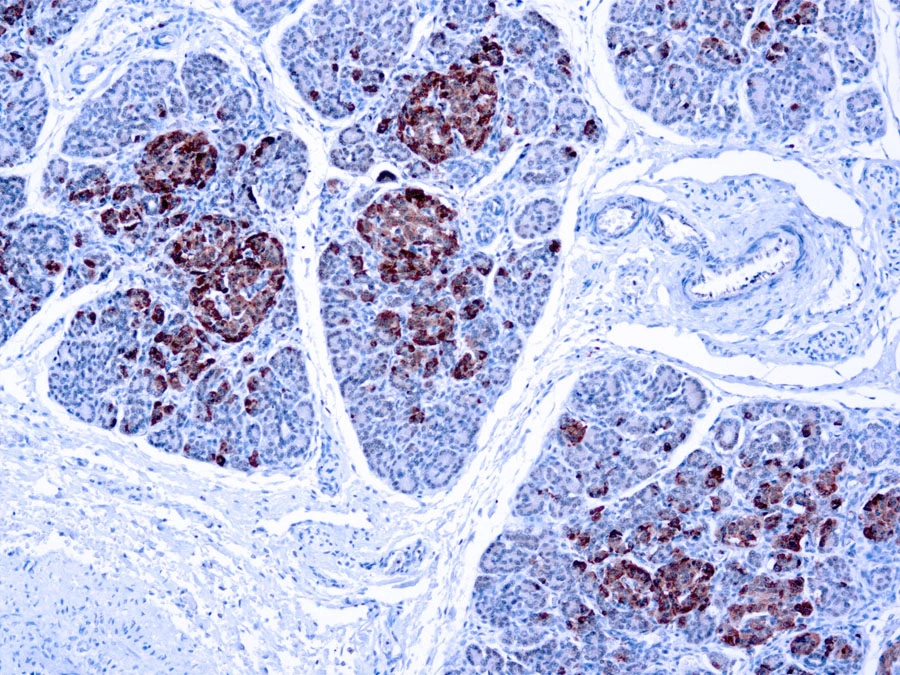Chromogranin A antibody [LK2H10] (ready-to-use)
GTX73638
ApplicationsWestern Blot, ImmunoHistoChemistry, ImmunoHistoChemistry Frozen, ImmunoHistoChemistry Paraffin
Product group Antibodies
TargetCHGA
Overview
- SupplierGeneTex
- Product NameChromogranin A antibody [LK2H10] (ready-to-use)
- Delivery Days Customer9
- Application Supplier Note*Optimal dilutions/concentrations should be determined by the researcher.Not tested in other applications.
- ApplicationsWestern Blot, ImmunoHistoChemistry, ImmunoHistoChemistry Frozen, ImmunoHistoChemistry Paraffin
- CertificationResearch Use Only
- ClonalityMonoclonal
- Clone IDLK2H10
- ConjugateUnconjugated
- Gene ID1113
- Target nameCHGA
- Target descriptionchromogranin A
- Target synonymsCGA, PHE5, PHES, chromogranin-A, SP-I, betagranin (N-terminal fragment of chromogranin A), catestatin, chromofungin, parathyroid secretory protein 1, pituitary secretory protein I
- HostMouse
- IsotypeIgG1
- Protein IDP10645
- Protein NameChromogranin-A
- Scientific DescriptionThe protein encoded by this gene is a member of the chromogranin/secretogranin family of neuroendocrine secretory proteins. It is found in secretory vesicles of neurons and endocrine cells. This gene product is a precursor to three biologically active peptides; vasostatin, pancreastatin, and parastatin. These peptides act as autocrine or paracrine negative modulators of the neuroendocrine system. Two other peptides, catestatin and chromofungin, have antimicrobial activity and antifungal activity, respectively. Two transcript variants encoding different isoforms have been found for this gene. [provided by RefSeq, Sep 2014]
- Storage Instruction2°C to 8°C
- UNSPSC12352203
References
- Polyclonal Crypt Genesis and Development of Familial Small Intestinal Neuroendocrine Tumors. Sei Y et al., 2016 Jul, GastroenterologyRead more
- Heparin-binding epidermal growth factor-like growth factor stimulates androgen-independent prostate tumor growth and antagonizes androgen receptor function. Adam RM et al., 2002 Dec, EndocrinologyRead more


![IHC-P analysis of human pancreas tissue using GTX17724 Chromogranin A antibody [rCHGA/413].](https://www.genetex.com/upload/website/prouct_img/normal/GTX17724/GTX17724_20200115_IHC-P_858_w_23060620_226.webp)
![ELISA analysis of antigen using GTX60690 Chromogranin A antibody [1A6B6]. Black : Control antigen 100ng Purple : Antigen 10ng Blue : Antigen 50ng Red : Antigen 100ng](https://www.genetex.com/upload/website/prouct_img/normal/GTX60690/GTX60690_20170912_ELISA_w_23061123_618.webp)
![IHC-P analysis of human small bowel tissue using GTX01895 Chromogranin A antibody [5H7]. Note cytoplasmic staining of neuroedocrine cells.](https://www.genetex.com/upload/website/prouct_img/normal/GTX01895/GTX01895_20200811_IHC-P_29_w_23053121_789.webp)
